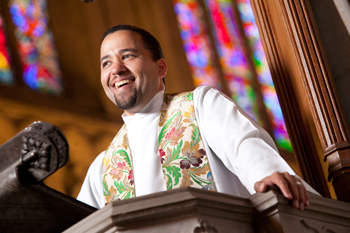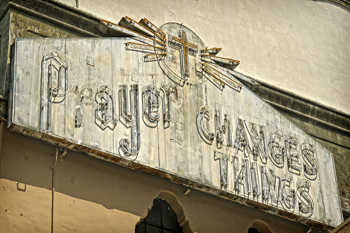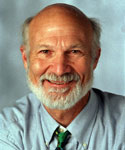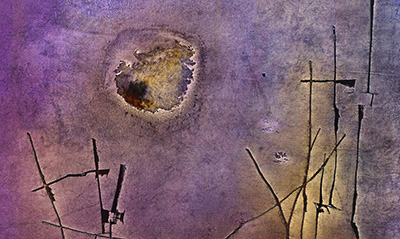Luke 13:10-17 (NRSV)
Editor’s note: Faith & Leadership offers sermons that shed light on issues of Christian leadership. This sermon was preached on Orientation Sunday, Aug. 25, 2013, in Duke University Chapel. A video of the service is online.
Welcome to Duke Chapel, or what James B. Duke called the “great towering church” -- or what I like to think of these days as “my office.”
A symbolic building built in the early 1930s at the heart of the university. It is the icon of the university. Neo-Gothic architecture with limestone arches. Seventy-seven stained-glass windows. A 50-bell carillon. A history of preaching and sacred music that matches any cathedral in the world.
Some call it the only Episcopalian cathedral in the state of North Carolina; the problem with that is we are not Episcopalian but interdenominational. Everyone wants to claim us, because of the great tradition here. As you enter the building, you might as well be stepping back in time.
If you go to the Memorial Chapel (to my right), you will step back in time for real. You will step right into where some of the Duke family rests. Benjamin Duke. Washington Duke. James B. Duke. There is history and tradition welded into this structure.
If the walls could talk, I can imagine what stories we might hear. Stories like why we have chairs in the front section and not pews. Stories of a green devil, not a blue devil, in a stained-glass window. Stories of wooden mice peeking out in a few chapel spots to participate in worship. Stories of all of those who have been married here, buried here, baptized here, who have preached here, sung here. Stories of those who designed and built this building.
There is a rich tradition here echoing in the nave’s acoustical atmosphere. Even the historical motto of the university -- eruditio et religio -- still rings true.
But what I love about Duke is that even with such an interesting and rich tradition (though very young compared with the Ivy League’s), there is innovation. How else can you explain the presence of our very own President Brodhead on “The Colbert Report” on Comedy Central?
Or take the president’s address to the incoming freshman during undergraduate convocation, in which he talked about his supernatural powers and formed a musical conspiracy with the chapel organist, Dr. David Arcus, to demonstrate them. You can’t get more innovative than that!
Or take Robert Lefkowitz, Duke’s first homegrown Nobel laureate, who received the Nobel Prize in chemistry last year for his work on G protein-coupled receptors. Yet you’ll find Bob throwing out the first pitch at a recent Durham Bulls game. He’s such an innovator that if you go to his office you’ll be able to find him, because there’s a sign that says Lefkoville; to some, this trumps Krzyzewskiville, or K-ville.
Innovation and creativity
Duke is not just an institution of tradition. It is one that embraces innovation and creativity.
How much more creative can you get than to hire a “Bapticostal” as dean of a chapel filled with Anglican-Methodist liturgical leanings and located at a Top 10 elite research university?
God is creative and innovative. Over and over again, we see this at Duke, with all of its interdisciplinary institutes -- institutes for brain sciences, ethics, humanities, environmental policy solutions, genome sciences and policy, global health, and social science research. Duke is on the cutting edge of research, innovation and discovery, though rooted in a certain tradition.
Stretching the boundaries of knowledge and understanding. Playing jazz and improvising within a certain academic structure.
There’s a delicate dance between tradition and innovation, because the latter is not always welcomed. One can be so entrenched or entombed in a tradition that innovation and flexibility and newness are quenched.
We see this with Jesus this morning. Jesus does not make an appearance on “The Colbert Report,” but he’s innovative, while at the same time working within a tradition. Jesus is not motivated by starting a revolution to demolish the religious tradition of his upbringing. In fact, he works within it.
“He was teaching in one of the synagogues on the sabbath” (Luke 13:10). He was doing what rabbis did. He operates within a tradition. To be in a synagogue on the Sabbath was at the heart of Judaism. Jesus does not tell Judaism, including the religious law, to “hit the road, Jack, and don’t you come back no more.”
Rather, he embodies a both-and, not an either-or, posture. One could say that Jesus embodies an example of “traditioned innovation.” However, it is the perceived innovation that gets him in trouble. He works within a tradition, but he is not enslaved by it. He is free from it, though he respects it.
He represents how tradition is different from traditionalism. Historian Jaroslav Pelikan, who taught at Yale for many years, noted this difference. He wrote, “Tradition is the living faith of the dead; traditionalism is the dead faith of the living.” Jesus bears witness to tradition by being innovative in ways that attempt to preserve the life-giving character of the tradition.
This becomes crystal-clear with what happens when he sees “a woman with a spirit that had crippled her for eighteen years” (Luke 13:11). Jesus allows himself to be interrupted. This woman’s presence pierces the normal protocol, and what Jesus reveals is that a person takes priority over the usual protocol.
Here is a woman unnamed -- only known as the crippled woman, because she was bent over and could not stand up straight. Her body said it all -- not only bent over and imprisoned by her physical ailment but bent and burdened by an interpretation of a religious law that quarantined certain days for healing.
She suffered under the weight of her gender and physical disability, because she was ostracized socially for it. For 18 years she was trapped by a certain perspective within a religious tradition in which protocol was more important than people.
That is, until she encounters Jesus, who is “person-driven.”
Pastor Rick Warren of the Saddleback Church in California wrote a New York Times best-selling devotional book in 2002 titled “The Purpose-Driven Life”; it is off the charts in terms of sales. But Jesus led a person-driven life; that is his purpose.
He is person-centered and reveals what might be called the privilege of personhood. People take priority over programs and traditional protocol. For Jesus, it is not that the Jewish law or tradition is unimportant; it is just that he privileges the person.
The woman doesn’t approach Jesus. She makes no request of him. There is no mention of her faith, and she’s not wearing a WWJD bracelet with all of the Jesus groupies to lure Jesus her way. Jesus takes the initiative to speak to her and to touch her.
And when he tells her, “You are set free from your ailment” (Luke 13:12), this is when we realize that his ministry messes with the tradition, or some might say, “messes up” the tradition. But he isn’t messing it up; he’s making it what it’s supposed to be.
However, not everyone is happy with this perceived innovation. One leader of the synagogue is indignant because Jesus has cured on the Sabbath. A commentator (Alyce McKenzie) has noted that the woman has a “partial view seat,” like at a Broadway musical, due to her being bent over. But so does the leader of the synagogue in this story!
The partial view does not encompass the entire view of reality. It can even distort the view of what is truly happening on the stage of life. A rigid religiosity may be so distorted that protocol is more important than people. “There are six days on which work ought to be done,” the leader said; “come on those days and be cured, and not on the sabbath day” (Luke 13:14).
This leader was not uncomfortable because Jesus healed someone but because this healing occurred on the Sabbath. The timing was his issue -- as if there were ever a bad time for freedom. But Jesus alters the religious standard.
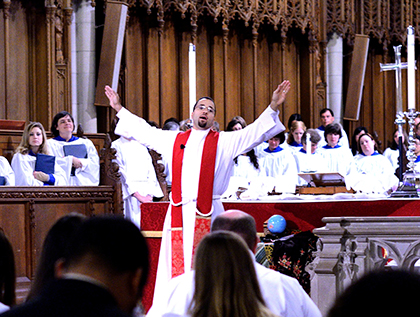
A gift from God
Some were put to shame, but others rejoiced at his innovation. In first-century Judaism, everyone wasn’t on the same page about Sabbath practices. The Jewish Sabbath commemorates the seventh day [of creation], on which God rested.
Regulations against work on the Sabbath were originally intended to provide access to this life in God. Sabbath laws did not restrict God’s activity in the world, and the healing of this woman is a gift from God, not a human work. Sabbath laws were intended for renewal, not rigidity. The law was established to be liberating, not restrictive.
A particular perspective on the Sabbath law may represent the tyranny of tradition -- binding people rather than freeing them, and therefore becoming a heartless religion. A religious tradition without a heart hurts people more than it helps, because its rules, regulations, customs, habits oppress people and do not have the people’s best interests at heart. Sabbath was for the spiritual health of the people.
When a law obstructs God’s desire for all of God’s children to be restored to full dignity and human community, whatever day of the week it is, then you know something has gone awry. This is religious tradition without a heart and soul and God, because Jesus is person-driven and prioritizes people’s needs.
In their book “No Longer Invisible: Religion in University Education,” Douglas and Rhonda Jacobsen assert that religion has made a comeback to university education in the last two decades and that it is no longer invisible but visible and more pluriform than in the past. Multiple faiths “mingle together” in this “religio-secular world.”
They say that even if one wanted to keep religion out of the academy, it would be virtually impossible today. In this landscape, they present six sites of engagement at the university: religious literacy, interfaith etiquette, framing knowledge, civic engagement, convictions, and character and vocation.
The latter three have to do with personal identity and purpose. To be religiously engaged in our day, one has to include the personal -- persons and their needs. This is not outside the domain of religious tradition; it is part and parcel of it. I would argue that the person is the heart of it, for without people, there is no church -- because the church is the people -- not even a glorious, stained-glass, Gothic building.
Community, healing and joy
The innovative move is to center in on people while remaining within a certain tradition and structure.
What Jesus faces is an interpretation of a traditional law that suffocates the adherers of the tradition by squeezing the life out of the tradition. How do I know this? “Does not each of you on the sabbath untie his ox or his donkey from the manger, and lead it away to give it water? And ought not this woman, a daughter of Abraham whom Satan bound for eighteen long years, be set free from this bondage on the sabbath day?” (Luke 13:15-16).
We should know the system is broken when donkeys are treated better than this daughter of Abraham. This specific legal perspective binds rather than releases one. It stifles rather than gives life. The woman is not the only thing crippled in this story. The whole system that keeps her crippled is also crippled.
Some religious practices or concepts may become hindrances to the flourishing of all humanity. We may sometimes, and even unknowingly, promote laws or ideas that keep others bent over and oppressed rather than free to live and be who God wants them to be. Rather than midwifing joy into the world, religious traditions may promote joyless, loveless and hopeless behaviors.
The clarifying question for ourselves may be a version of a question Howard Thurman asked in his writings: What do our religious teachings “have to say to those who stand, at a moment in human history, with their backs against the wall [-- or bent over] … the poor, the disinherited, the dispossessed [-- the crippled woman]”?
Jesus, who operates well within the tradition, will not allow the tradition to exclude people from access to the community, healing and even joy. He does not break the Sabbath but restores its life-giving possibilities. He comes to restore the tradition to wholeness and restore the joy of tradition through innovation, because tradition loses its joy when it has anthropological amnesia and forgets humanity and its needs.
On this Orientation Sunday, Jesus is trying to reorient the heart of religion by trying to give it a heart, a heart for people, a heart for our peers, a heart even for the Tar Heels (football season is coming). Jesus tries to restore the tradition to be freeing and joyous once again, not restrictive and lamentful, dour and sour.
In fact, this story is not really about healing either. It is about the irruption of disruption into business as usual, plans as usual, life as usual. The status quo was comfortable and familiar, but it can be stagnant, as this story reveals.
But Jesus disrupts the numb tradition through his innovation within the tradition. He prepares us to be surprised. To be ready for something to irrupt. To anticipate divine spiritual disruption in life. To be ready for God to play jazz during our Christian journey.
Jazz as a musical genre brings together tradition and innovation. Musically, jazz moves within a certain musical chord progression, yet it improvises freely within that structure. Jazz represents freedom and fluidity but engages in a call and response with the musical tradition. Yet it is not an ossified tradition, as it gestures toward new possibilities and melodies and directions. It points to hope and a future. As Louis Armstrong, the great jazz trumpeter, once said, “To jazz or not to jazz, there is no question!”
It is no question that God improvises and innovates and moves in mysterious and surprising ways, if we have ears to hear the music.
In a 1955 issue of Time magazine, a Presbyterian pastor interviewed jazz pianist Dave Brubeck and asked, “Dave, what’s the secret? We could use some of that magnetism to fill our churches.” Brubeck responded by saying there is no secret, only that jazz reflects the hopes, dreams and frustrations of the generation. In other words, Brubeck echoes Armstrong, who says, “What we play is life.”
A jazzlike Jesus not only innovates and improvises within a tradition, but he’s in touch with life, with people, and he literally “laid his hands” on the woman (Luke 13:13) to disrupt the norm in order to restore joy to this woman’s life. He improvises so that she can be free, loosed from binding structures.
We see that not everyone can handle spiritual improvisation and innovation or disruption. Not everyone appreciates jazz. This disruption of the Spirit may disturb some, but it will liberate others by breaking out of confining norms, crossing boundaries to help someone in need even if the social or religious standards dictate otherwise.
This so-called disruption is an irruption of joy like the gift of the Spirit at Pentecost. It restores joy and newness and freedom, because it is an irruption of the in-breaking of the kingdom of God.
Jesus ushers in the possibility of being, to use the words of C.S. Lewis, “surprised by joy.” He does so by adhering to the spirit of the law and not necessarily the letter of the law. The results of his actions reveal the surprising and unexpected in-breaking sign of the kingdom -- the straightening of a woman’s spine.
The kingdom comes in surprising forms like mustard seeds and yeast; something small can represent something new within a larger tradition. The innovation of Christ orients us to life in the kingdom and calls us to “daring acts of imagination” (Walter Brueggemann), in which we courageously imagine the world healed and straightened out. Called to a mission of innovation and unimagined newness.
And although new, it is not unrecognizable, because “the memory of things gone is important to a jazz musician” (Louis Armstrong) -- or a jazz theologian. We are still a part of the Christian tradition. One does not obliterate and destroy the past or the tradition, but one works to restore its joy; thus, we are open to divine disruption, even as a new school year begins.
We will be free
God may disrupt what we thought university was all about or who we thought God was or what we thought education was or what we thought about this or that subject. God will usher in new ideas and new friends and new professors and new possibilities for your future. It will be a new experience of life and of God, because the kingdom is always surprising.
It may not always be comfortable, and things may not always go as planned, but as Dean Steve Nowicki said at convocation this past week, an oyster will only produce a pearl when it is uncomfortable.
May you be open to be surprised by joy through the innovative ministry of Jesus this year. Because when the woman’s back was straightened out, Jesus was straightening out the broken tradition at the same time.
This orientation to the kingdom of God caused an irruption of joy to take place as the woman stood up straight and praised God while the entire crowd rejoiced at her freedom. She was loosed to experience God’s joy.
This is what happens when we privilege people over the usual protocol. Joy breaks out. She was free to be who God had called her to be, and this caused others to rejoice as well, because they recognized that “I can never be what I ought to be until you are what you ought to be” (Martin Luther King Jr.).
Jesus was restoring the joy of tradition and community so that everyone could be like that child who was swinging on a park swing who was so free that she said her heart was laughing! Oh that we might have laughing hearts again and experience the joy of freedom in Christ.
And when we are freed ourselves, may we recognize the call to free others who are bound by systems and structures and religious philosophies and laws and ideologies and economies and stereotypes, so that they might be restored to full human dignity and experience the joy of God.
The privilege of personhood is not an excuse to hang out all night with friends the night before a final exam. But it does mean you may encounter peers who are in need because they are bent over by the weight of life and need a freeing and loving word or caring touch.
Something small may represent something big like the kingdom of God. That might be the very thing that will cause them to stand up straight again and live a life of praise and joy, so that we all can stand up and receive and restore the joy of God in the world.
And when you are standing -- in honor of the 50th anniversary of Martin Luther King’s “I Have a Dream” speech at the March on Washington, which is this coming week -- stand up until this nation lives out the true meaning of its creed that all people are created equal.
Stand up until the day when people “will not be judged by the color of their skin but by the content of their character.” “Stand up for freedom together, knowing that we will be free one day.” Stand up and let freedom ring, when we “will be able to join hands and sing in the words of the old Negro spiritual, ‘Free at last! Free at last! Thank God Almighty, we are free at last!’”
And then the formerly crippled woman will not be the only one free. We will be free. The world will be free. Then we can text and say to all of our friends what I imagine the freed woman wrote on the ground as she praised God -- TGIF. Thank God, I’m free.


